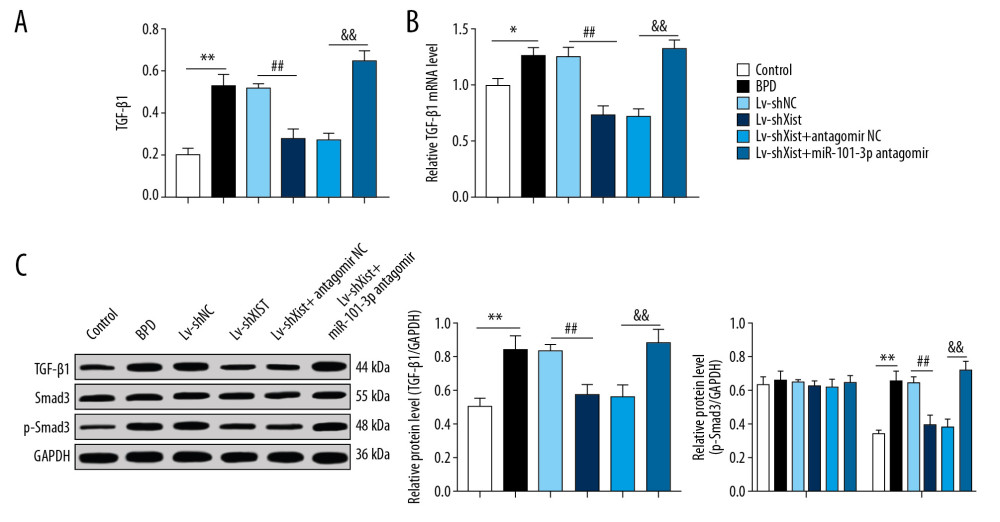18 October 2020: Animal Study
Silencing of Long Non-Coding RNA X Inactive Specific Transcript (Xist) Contributes to Suppression of Bronchopulmonary Dysplasia Induced by Hyperoxia in Newborn Mice via microRNA-101-3p and the transforming growth factor-beta 1 (TGF-β1)/Smad3 Axis
Wenhao Yuan 1ABCDEF* , Xiaoyan Liu 1ABCDG* , Lingkong Zeng 1BCDFG* , Hanchu Liu 1ABCDEFG , Baohuan Cai 2ABCDEFG , Yanping Huang 1ABDF , Xuwei Tao 1ABCDF , Luxia Mo 1ABDF , Lingxia Zhao 1BCDF , Chunfang Gao 1BCDFDOI: 10.12659/MSM.922424
Med Sci Monit 2020; 26:e922424

Figure 5 Silenced Xist competitively combines with miR-101-3p to suppress HMGB3 and negatively regulates the TGF-β1/Smad3 axis. (A) ELISA found that the high protein level of TGF-β1 in BPD mice was reduced with silenced Xist. (B) RT-qPCR showed that the highly expressed mRNA of TGF-β1 in lung tissues of newborn BPD mice were inhibited after silencing Xist. (C) Western blot analysis suggested that the high protein level of TGF-β1 and Smad3 phosphorylation in lung tissues of BPD mice were inhibited after silencing Xist. One-way ANOVA was performed to determine data in panels A–C, and two-way ANOVA was performed to determine data in panel D, Tukey’s multiple comparisons test was applied for post hoc test. * p<0.01, ** p<0.01, ## p<0.01, && p<0.01, n=3. Xist – X inactive specific transcript; miR – microRNA; HMGB3 – high-mobility group protein B3; TGF-β1 – transforming growth factor-beta 1; Smad3 – drosophila mothers against decapentaplegic 3; ELISA – enzyme-linked immunosorbent assay; BPD – bronchopulmonary dysplasia; RT-qPCR – reverse transcription-quantitative polymerase chain reaction; ANOVA – analysis of variance.


